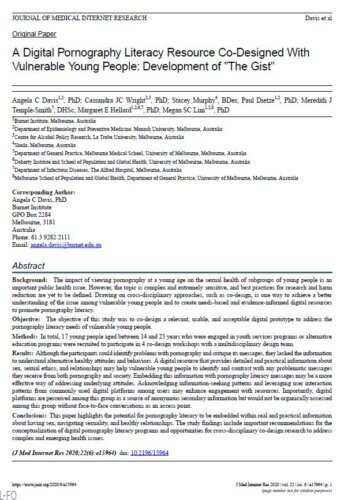Sexuality Education & Therapy with Children
A Digital Pornography Literacy Resource Co-Designed With Vulnerable Young People: Development of “The Gist”.
Open Access: Yes.
Abstract
Background: The impact of viewing pornography at a young age on the sexual health of subgroups of young people is an important public health issue. However, the topic is complex and extremely sensitive, and best practices for research and harm reduction are yet to be defined. Drawing on cross-disciplinary approaches, such as co-design, is one way to achieve a better understanding of the issue among vulnerable young people and to create needs-based and evidence-informed digital resources to promote pornography literacy.
Objective: The objective of this study was to co-design a relevant, usable, and acceptable digital prototype to address the pornography literacy needs of vulnerable young people.
Methods: In total, 17 young people aged between 14 and 23 years who were engaged in youth services programs or alternative education programs were recruited to participate in 4 co-design workshops with a multidisciplinary design team.
Results: Although the participants could identify problems with pornography and critique its messages, they lacked the information to understand alternative healthy attitudes and behaviors. A digital resource that provides detailed and practical information about sex, sexual ethics, and relationships may help vulnerable young people to identify and contrast with any problematic messages they receive from both pornography and society. Embedding this information with pornography literacy messages may be a more effective way of addressing underlying attitudes. Acknowledging information-seeking patterns and leveraging user interaction patterns from commonly used digital platforms among users may enhance engagement with resources. Importantly, digital platforms are perceived among this group as a source of anonymous secondary information but would not be organically accessed among this group without face-to-face conversations as an access point.
Conclusions: This paper highlights the potential for pornography literacy to be embedded within real and practical information about having sex, navigating sexuality, and healthy relationships. The study findings include important recommendations for the conceptualization of digital pornography literacy programs and opportunities for cross-disciplinary co-design research to address complex and emerging health issues.
Relevance
“Most formal pornography literacy programs focus on the critical awareness of pornographic content and the industry. We found that our users understood pornography as obviously unrealistic and could already critique its messages.” Hence, “a key message of this study is that effective pornography literacy programs must expand their focus on problematic messages from pornography and go beyond critical media literacy to include alternative information to help young audiences to navigate sexuality and relationships in their lives.”
“Our findings suggest that there is potential to embed pornography literacy within practical information about ethical sex and relationships to help young people transfer critical
literacy into alternate choices and preferences in real life.”
“We found that for vulnerable young people, there were critical unmet information needs in relation to the basics of navigating sex and relationships that compounded fetishized representations
in pornography. Thus, having relevant and accessible alternative information may be even more vital for vulnerable young people whose basic needs may not be met by schools, parents, or peers.”
Citation
Davis, A. C., Wright, C. J., Murphy, S., Dietze, P., Temple-Smith, M. J., Hellard, M. E., & Lim, M. S. (2020). A Digital Pornography Literacy Resource Co-Designed With Vulnerable Young People: Development of “The Gist”. Journal of medical Internet research, 22(6), e15964. https://doi.org/10.2196/15964

